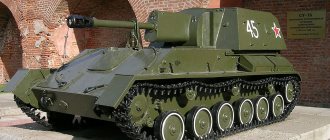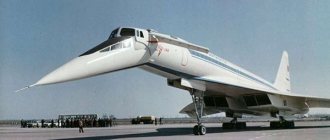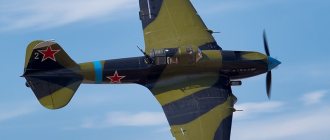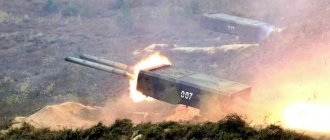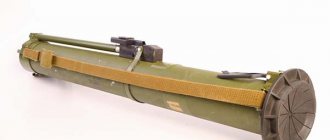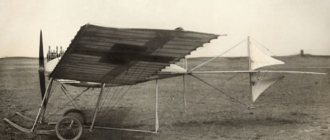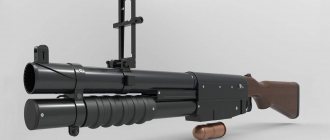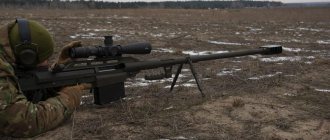Home » Smoking room. Anything and everything your heart desires. » Mitrailleuse - predecessor of the machine gun
Smoking room. Everything and about everything your heart desires. Small arms of the past, present and future
admin 04.10.2019 1518
18
in Favoritesin Favoritesfrom Favorites 8
Yes, yes, every epoch-making invention always has its own ancestors, and the mitrailleuse was, in a sense, one of the ancestors of the machine gun, and perhaps the closest! After all, people wanted to learn how to quickly shoot at the enemy for a very long time, and so, not knowing a machine gun, they came up with it, and for some time it completely replaced it for them. And it’s about the mitrailleuse, the predecessor of all modern machine guns, that our story will be told today.
“Kropilo”, “magpie” and “Pakla’s gun”
And it so happened that even at the dawn of the use of firearms, there were smart people among its supporters who noticed its drawback, that it took a very long time and troublesome time to load it! Well, in fact, while you pour gunpowder into the barrel, insert a wad there, then a bullet, then pour gunpowder into the ignition hole again, and fan the burning fuse, you are essentially completely defenseless, and you can be easily killed, and many times!
And already during the Hussite Wars and the English king Henry VIII century. In the armies of many countries, so-called “shooting clubs” appear - 5,6,7 or shorter barrels, chained together with metal hoops and attached to a wooden handle. They held it under the arm, and, turning it with one hand, brought the wick to them with the other, which made it possible to shoot at the enemy with a real “burst.” Well, then, in order not to reload them with such a “weapon,” they went into hand-to-hand combat, since there was simply nothing in it that could be damaged by blows.
Henry VIII had such a device in his personal use and was called a “sprinkler”, but the famous conqueror of Siberia Ermak Timofeevich was armed with a “magpie” - a two-wheeled carriage with seven barrels attached to it at once, which also fired in turn. Soon, the imagination of gunsmiths completely ran wild and 20, 40 and even 60-barreled so-called “organ” guns were used, which were small-caliber barrels on frames, the ignition holes of which had a common groove, which is why they ignited and fired sequentially. But once the shooting started, it was no longer possible to stop it, they took a very long time to charge, and it was very difficult to aim from such “organs.”
Nine-barreled cannon from the Army Museum in Paris
In the Army Museum in Paris there is even an artillery piece with nine channels drilled into one barrel. Moreover, the channel that is located in the middle has a larger caliber than the 8 side ones. This “miracle gun” was apparently used like this: at first they fired from it in the same way as from a conventional gun, and then when the enemy was close, they began to shoot from all these additional channels.
Simultaneously with the “organs”, the so-called “espiñol” was adopted. This weapon had only one barrel, but the charges were placed in it when loading one after the other, and were ignited from the side of the barrel using a ignition cord. After this, the shots followed one after another without stopping. However, such an “unguided weapon” turned out to be quite dangerous, since it was enough for the powder gases from one charge to break through to the others, and its barrel would immediately burst. It was necessary to somehow isolate the charges from each other, and this is how systems appeared in which the charges and bullets were in a special drum, and were set on fire either with a wick or an ordinary flintlock.
One of the inventions in this area was made by an English lawyer from London, James Puckle, who patented the “Puckle Gun” in 1718. It was a barrel placed on a tripod with an 11-round drum-cylinder in the breech. Each new shot was fired by turning the drum, like in a revolver. After the ammunition was used up, the used cylinder was replaced with a new one, which made it possible to fire up to nine rounds per minute. The combat crew consisted of several people, and Pakl intended to use his “gun” on ships to fire at enemy boarding teams.
It is interesting that he developed two versions of his weapon: with spherical lead bullets, which were common for those years, and with cubic bullets, which were believed to cause more injury and be used exclusively against Muslim enemies (including the Turks). However, for some reason Pakl’s creation did not make an impression on his contemporaries. Mitrailleuse is a French word.
Militant Lawyer
On May 17, 1718, an ordinary lawyer appeared at the London patent office. James Puckle brought the notary drawings of the infernal machine, modestly called the “Puckle Gun.” This gun is considered today to be the first prototype of a real rapid-fire machine gun.
Joseph Montigny's first card game
Meanwhile, already at the beginning of the 19th century. A technical revolution began in Europe, steam-powered machines appeared, and the accuracy of the parts produced on them increased sharply. In addition, unitary cartridges were created that combined gunpowder, primer and bullet into a single ammunition, and it was all this together that led to the appearance of mitrailleuse or grapeshot. This name comes from the French word for buckshot, although it should be noted that the buckshots themselves did not shoot with buckshot, but with bullets, but this was already the case from the very beginning, since the very first mitrailleuse, which was invented in 1851 by the Belgian manufacturer Joseph Montigny, and France adopted it into service with its army. Enviable ingenuity
It must be said that Montigny showed great ingenuity, since the weapon he created was distinguished for that time by very good fighting qualities and the originality of the device. She had exactly 37 13-mm caliber barrels, and all of them were loaded simultaneously using a special plate-clip with holes for cartridges, into which they were inserted and held by the edges. The plate along with the cartridges had to be inserted into the grooves behind the barrel, after which they were all pushed into the barrels with a special lever, and the bolt itself was locked tightly.
To start shooting, you had to twist the handle installed on the right side, and it, through a worm gear, lowered down a special plate that covered the firing pins installed in front of the cartridge primers. At the same time, special spring-loaded rods hit the strikers, which is why the shots followed one after another as the plate lowered. This happened because its upper edge had a stepped profile, and the rods jumped out of their sockets and hit the strikers in a certain order. An experienced crew could replace the plate with a new one within five seconds, which made it possible to achieve a rate of fire of 300 rounds per minute. But even a more modest figure of 150 rounds per minute was an excellent indicator at that time. In another version of this mitrailleuse designed by Verchères de Reffi, the number of barrels was reduced to 25, but its rate of fire did not change.
Mitrailleuse de Reffi from the Army Museum in Paris
Mitrailleuses were used by the French during the war with Prussia in 1871, but without much success, since the weapon was new, and they simply did not know how to use it correctly.
Design problems
Puckl didn't take into account too many things to succeed. The silicon system required adding primer to the shelf after each shot - not the rate of fire, but only an ersatz one. In addition, the design of the Pakla gun was quite complex, expensive and unreliable in real combat: the locking mechanism of the drum was weak and the crew risked being left with a useless gun at any moment.
Mitrailleuses start and lose
And then it happened that in 1861, a civil war began in America between the North and the South, and military inventions on both sides fell like a cornucopia. For example, the “Ager Coffee Grinder” had one barrel and also a handle on the side, but it had a multi-shot breech into which the servants poured cartridges through a wide bell on top when firing.
Then in 1862, the American Richard Gatling, a doctor by profession, designed a mitrailleuse with rotating barrels and a magazine located above them, which he called a “battery gun.” The installation had six 14.48 mm barrels rotating around a central axis. The drum store was on top. Moreover, he constantly improved his mitrailleuse, so that its reliability and rate of fire increased all the time. For example, already in 1876, a five-barrel model of 0.45-inch caliber allowed firing at a rate of fire of 700 rounds per minute, and when firing in short bursts it increased to an unimaginable at that time 1000 rounds per minute.
Richard Jordan Gatling
At the same time, the barrels themselves did not overheat at all - since no one barrel fired more than 200 rounds per minute, and besides, the air flow created during rotation appeared, which cooled them. So we can say that the Gatling mitrailleuse was the first more or less successful machine gun, despite the fact that it was controlled manually and not by some kind of automation!
Gatling mitrailleuse on a wheeled carriage. Back view. Note the round shield at the end of the barrel to protect against enemy bullets
The Southern Confederates also had their own Williams-designed canister, which had a caliber of 39.88 mm and fired 450-gram bullets. The rate of fire was 65 rounds per minute. It turned out to be very heavy and cumbersome, so it was not widely used, but the “Gatlings” eventually spread throughout the world and came to both England and France.
But this futuristic-looking installation is also a Gatling model of 1895 from the Army Museum in Paris. Moreover, it can be removed from a wheeled gig and installed directly on the ground!
The Gatling system was also adopted in Russia, in a version with fixed barrels developed by Colonel A. Gorlov and inventor V. Baranovsky, and both models had a rate of fire of up to 300 rounds per minute. They also had a chance to “smell gunpowder” in the battles of the Russian-Turkish War of 1877–78, and they performed quite well.
Gatling mitrailleuse, model 1876. Fort Laramie, Wyoming, USA.
In the 70s of the 19th century. The Norwegian gunsmith Thornsten Nordenfeld proposed his mitrailleuse, and it had a simple design, compactness, and high rate of fire, and the cartridges were fed from one common horn-type magazine for all its five fixed barrels. The barrels in it were installed horizontally in one row and fired in turn, and its perfection was such that at some stage it even seriously competed with the Hiram Maxim machine gun that appeared in 1883.
Nordenfeld mitrailleuse, rear view
Around the same time, the American Benjamin Hotchkiss, a native of Watertown, Connecticut, developed another five-barrel mitrailleuse of 37 mm caliber, but only with a rotating block of barrels. The first Hotchkiss, a multi-barreled gun with rotating barrels, is often described as a variant of the Gatling, although its design was quite different from it. Hotchkiss himself emigrated to France from the USA, where he created his own production of “revolving guns”
37 mm Hotchkiss gun mounted on the deck of a ship
Its first gun was demonstrated in 1873, and performed well, although it fired much slower than its competitor, the four-barreled Nordenfeld. This one-inch (25.4 mm) mitrailleuse fired 205 gram steel projectiles, and could fire up to 216 rounds per minute, while the 37 mm Hotchkiss "revolver" fired cast iron projectiles weighing 450 grams (1 lb) or even heavier cast iron shells filled with explosives, no more than 60, but in reality there were even fewer.
Moreover, it was designed in such a way that with each turn of the handle, one shot occurred, and the barrels themselves made five intermittent turns, and the projectile that entered the chamber from the magazine located on top was fired after every third turn, and the cartridge case was ejected between the fourth and fifth . Based on the test results, both models were accepted into service at once, but since the size of the destroyers was constantly growing.
As a result, Hotchkiss overtook Nordenfeld so much that in 1890 the latter’s company went bankrupt! But Hotchkiss’s five-barreled guns, even at the beginning of the 20th century, were still preserved on ships, where they were used to fight enemy high-speed destroyers. But on land, mitrailleuses lost to machine guns in all respects, although some of their copies were in service in the armies of different countries even in 1895!
Buckshot
Infantry units needed weapons capable of providing dense fire on the enemy and at the same time serving as a reliable barrier against cavalry attacks. To some extent, the solution was the invention of buckshot - but artillery was still too clumsy, a heavy monster, from which nimble horsemen escaped with relative ease. And buckshot also led to rapid wear of the barrels: an inexperienced commander risked being left on the battlefield without infantry and without guns.

